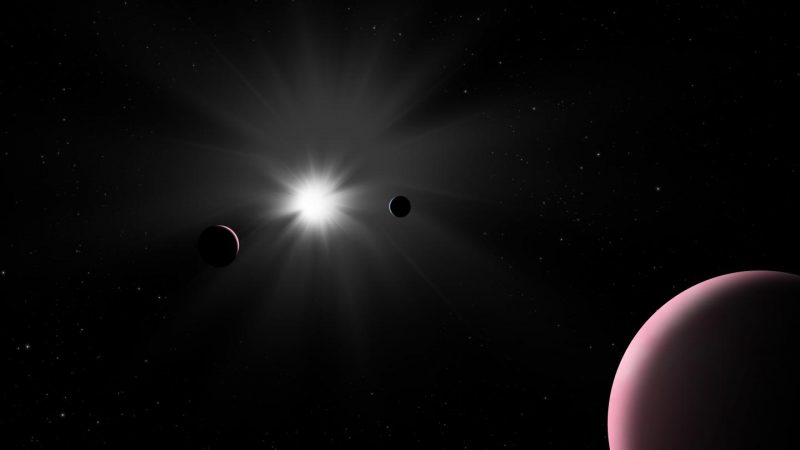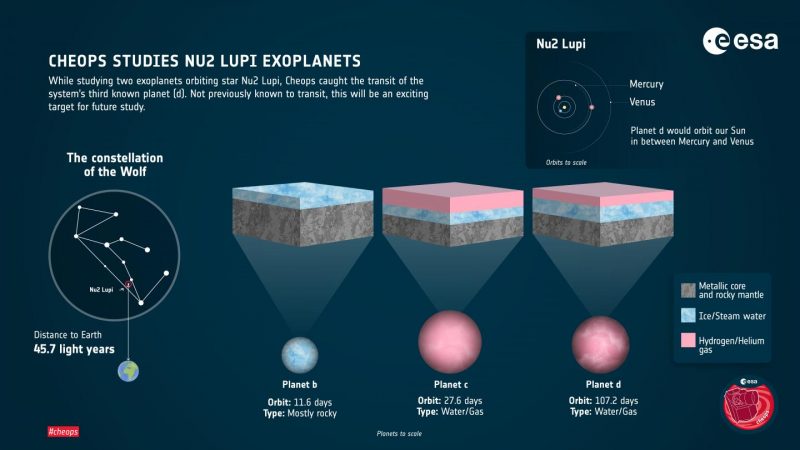
Astronomers said on June 28, 2021 that they were observing two planets orbiting a star some 50 light-years away, when a 3rd planet made a surprise photobomb of their image. The star is Nu2 Lupi. It’s visible with the unaided eye from Earth’s Southern Hemisphere, in the constellation Lupus the Wolf. Astronomers discovered the three planets around the star in 2019, whose “years” or orbital periods lasted 12, 28 and 107 days. Astronomers knew the two planets closest to the star would be visible as they transited – or crossed in front of – the star’s bright surface. But the appearance of the outermost known planet was a welcome surprise.
Because Nu2 Lupi is such a bright star – so relatively close to us – these scientists called the photobombing planet:
… a golden target for future study with no known equivalent.
The scientists published the study on June 28, 2021, in the peer-reviewed journal Nature Astronomy.
Distant planet makes surprise photobomb
The planets are named Nu2 Lupi b, c and d, with the A designation reserved for the star. The star shines at 6th magnitude in the constellation Lupus and is a G type star, the same type as our sun. Astronomers turned CHEOPS (CHaracterising ExOPlanet Satellite) at this planetary system to investigate the two inner planets. The farther a planet is from its star, the less likely it is to transit. Yann Alibert of the University of Bern, co-author of the study, said:
What makes these exoplanets really outstanding is that we can see them passing just in front of their star; they’re said to ‘transit’. We knew that already for the two inner planets, which led us to point CHEOPS to the system in the first place. However, the third planet is quite far away from the star, no one was expected to see its transit!

The photobomb of Nu2 Lupi d is the first time astronomers have seen a transit of a bright star by a planet with an orbit greater than 100 days. Discovering this planet is visible while transiting is valuable, because the farther out a planet is, the less radiation has blasted it, leaving it in a more pristine state. David Ehrenreich of the University of Geneva and mission scientist of CHEOPS, who co-signed the study, explained:
Due to its relatively long period, the amount of stellar radiation reaching the planet is mild in comparison to many other discovered exoplanets. The less radiation a planet receives, the less it changes over time. Therefore, a planet with a long period could have retained more information about its origin.
Since its bright host star is quite close to us, it is easier to study. This makes it a golden target for future study with no known equivalent.
Revelations from CHEOPS
CHEOPS measured Nu2 Lupi d at roughly 2.5 times the size of Earth and 9 times its mass. Laetitia Delrez of the University of Liege and lead author on the study, was able to specify the makeup of the planets in the system. She said:
The innermost planet is mainly rocky, while the outer two appear to be enshrouded in envelopes of hydrogen and helium gases beneath which they hold large amounts of water.

So much water, in fact, that astronomers believe the planets to be uninhabitable. While Earth is made up of less than 0.1 percent water, a quarter of the mass of the planets in the Nu2 Lupi system are water. This water is not in liquid form, and instead is either high-pressure ice or high-temperature steam.
This planetary system may have other secrets to uncover. Ehrenreich said:
Now that we discovered that all three planets transit and have precisely measured their properties, the next step is to study them with bigger and more powerful instruments than CHEOPS, like the Hubble Space Telescope or its successor, the James Webb Space Telescope. They could reveal further details, such as the composition of the atmosphere.

Bottom line: Swiss-led telescope CHEOPS unexpectedly captured a planet 50 light-years away when imaging its host star and other planets.
Source: Transit detection of the long-period volatile-rich super-Earth ?2 Lupi d with CHEOPS
https://earthsky.org/space/planet-surprise-photobomb-cheops-nu2-lupi/
2021-07-01 12:07:38Z
CBMiRWh0dHBzOi8vZWFydGhza3kub3JnL3NwYWNlL3BsYW5ldC1zdXJwcmlzZS1waG90b2JvbWItY2hlb3BzLW51Mi1sdXBpL9IBAA
Bagikan Berita Ini














0 Response to "Planet makes a surprise photobomb - EarthSky"
Post a Comment